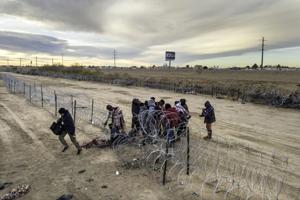
Fortress America and Festung Europa (Fortress Europe) are just starting to take shape; bare outlines of what they will have grown into 10 years from now. But the trend is almost unstoppable, and it will be very ugly when it’s finished. Some sort of turning point was reached in Germany this week, where the public was horrified by a knife attack in the western city of Solingen, in the midst of the celebrations for the city’s 650th anniversary.
Three people were killed and eight injured, allegedly by a lone attacker from Syria who had sought asylum in Germany as a refugee. Police carry out an operation at a refugee shelter which, according to the police, was connected to a fatal knife attack in Solingen, Germany, on Aug. 23.

There’s been a call to end Germany’s “naive” immigration policy. There has been no official word on the killer’s motives, but the fact that he shouted “Allahu akbar” throughout the attack was a useful clue. As you would expect, Friedrich Merz, the leader of the opposition Christian Democrats (CDU), called for an end to Germany’s “naive” immigration policy.
There’s a state election underway in Saxony at the moment, and Merz took the opportunity to present Chancellor Olaf Scholz with a list of demands that included a complete and immediate ban on letting asylum-seekers from Syria and Afghanistan enter Germany. This is a first: targeting specific nationalities for exclusion. Merz didn’t actually say “International law be damned! This is serious!” but that was the general tenor of his remarks.
Scholz, under pressure, promised to speed up deportations of asylum-seekers whose applications have been refused (roughly half). It probably won’t be enough, and his coalition is likely to lose the federal elections next year. On the same day, on the other side of the Atlantic, Democratic presidential candidate Kamala Harris was making peace with harsher popular attitudes toward immigration in the United States.
In 2017, she denounced Donald Trump’s beloved “wall” along the border with Mexico as “a stupid waste of money.” Now her TV ads show images of the same wall. It’s still a stupid waste of money, really, but it’s the image that counts.
Moreover, the underlying truth is that it’s entirely possible to close borders to unwanted people. Fences and walls don’t work very well, but killing only a small number of would-be illegal immigrants will deter all but a few of the rest from taking the same route. Migrants are not being killed yet in either Germany or the United States, although it’s getting pretty close in the Mediterranean.
The Italian and Greek authorities in particular do not always strive to rescue people whose flimsy, overloaded boats get into trouble while trying to cross from North Africa to Europe (1,341 deaths so far this year). It’s just a foretaste of what is to come, and a somewhat misleading foretaste at that. Probably around half of the current flows of migrants crossing Europe’s borders are genuine refugees from war, famine or political or religious persecution.
Most of the rest are so-called “economic migrants” seeking to raise their living standards and/or earn money to send home. Only a small minority of those who are coming now are “climate refugees,” people whose farms dried up and blew away, or are now permanently underwater, or victims of half a dozen other ways that climate change can destroy your livelihood. But this is the category of migrants whose numbers are certain to grow and grow.
The minuscule number of migrants who just want to murder infidels will continue to come, too, and the fear and hate they spread will coarsen the debate in all the European destination countries. The response may continue to be somewhat less cruel in the United States, where the main source countries for the migration in Latin America and the Caribbean do not include this fanatical element, but it won’t be pretty along America’s southern border either. Those who are paid to think about such things have long been deeply pessimistic about how we will handle these waves of refugees.
This is from a 2008 interview with Leon Fuerth, a former national security adviser in the Clinton administration: “Governments with resources will be forced to engage in long, nightmarish episodes of triage, deciding what and who can be salvaged from engulfment by a disordered environment. The choices will need to be made primarily among the poorest, not just abroad but at home. “At progressively more extreme levels, the decisions will be increasingly harsh: morally agonizing to those who must make and execute them — but in the end, morally deadening.
” Even the rich countries will be having a very hard time when the average global temperature rises 2 C. So how much concern will be shown for the needs of desperate foreigners hammering on the gates when such conditions prevail even inside them? The gates will stay firmly closed, and those outside them will die..














